2000 年 6 月英语六级真题及答案
Part I Listening Comprehension (20 minutes)
Section A
Directions: In this section, you will hear 10 short conversations. At the end of
each conversation, a question will be asked about what was said. Both the
conversation and the question will be spoken only once. After each question there
will be a pause. During the pause, you must read the four choices marked A), B),
C) and D), and decide which is the best answer. Then mark the corresponding letter
on the Answer Sheet with a single line through the center.
Example: You will hear:
You will read:
A) 2 hours.
B) 3 hours.
C) 4 hours.
D) 5 hours.
From the conversation we know that the two were talking about some work they will
start at 9 o’clock in the morning and have to finish at 2 in the afternoon. Therefore,
D) “5 hours” is the correct answer. You should choose [D] on the Answer Sheet and
mark it with a single line through the center.
Sample Answer [A] [B] [C] [D]
1. A) Buy some traveller’s checks.
B) Borrow some money from a friend.
C) Check the brakes and tires.
D) Spend some time travelling.
2. A) He is very forgiving and tolerant.
B) He probably has a poor memory.
C) He is well liked by his customers.
D) He has been introduced to the staff.
3. A) He thinks the book should include more information.
B) He doesn’t think it necessary to provide the answers.
C) The answers will be added in a later edition.
D) The book does include the answers.
�
4. A) Announce appeals for public service.
B) Hold a charity concert to raise money.
C) Ask the school radio station for help.
D) Pool money to fund the radio station.
5. A) She talked with the consultant about the new program until two.
B) She wouldn’t talk to the consultant before two.
C) She would talk to the consultant during lunch.
D) She couldn’t contact the consultant’s secretary.
6. A) They are equally competent for the job.
B) They both graduated from art schools.
C) They majored in different areas of art.
D) They are both willing to draw the posters.
7. A) At a book store.
B) At an art museum.
C) At a newspaper office.
D) At a gymnasium.
8. A) The woman received a phone call from Mark yesterday.
B) The man injured Mark in a traffic accident yesterday.
C) The man met a friend by chance.
D) The woman contracted Mark on business.
9. A) The man should stay up and watch the program.
B) The man should read something exciting instead.
C) The man should go to bed at eleven.
D) The man should give up watching the movie.
10. A) Students with a library card can check any book out.
B) Reference books are not allowed to be checked out.
C) Only students with a library card can check out reference books.
D) The number of books a student can check out is unlimited.
Section B
Directions: In this section, you will hear 3 short passages. At the end of each
passage, you will hear some questions. Both the passage and the questions will be
spoken only once. After you hear a question, you must choose the best answer from
�
the four choices marked A), B), C) and D). Then mark the corresponding letter on
the Answer Sheet with a single line through the center.
Passage one
Question 11 to 13 are based on the passage you have just heard.
11. A) To find out whether they take music lessons in their space time.
B) To find out whether they can name four different musical instruments.
C) To find out whether they enjoy playing musical instruments in school.
D) To find out whether they differ in their preference for musical instruments.
12. A) They find them too hard to play.
B) They think it silly to play them.
C) They find it not challenging enough to play them.
D) They consider it important to be different from girls.
13. A) Children who have private music tutors.
B) Children who are 8 or older.
C) Children who are between 5 and 7.
D) Children who are well-educated.
Passage Two
Questions 14 to 16 are based on the passage you have just heard.
14. A) Because there weren’t any professional teams in the U.S. then.
B) Because Pele hadn’t retired from the Brazilian National Team yet.
C) Because this fast-moving sport wasn’t familiar to many Americans.
D) Because good professional players received low salaries.
15. A) When it has a large number of fans.
B) When it plays at home.
C) When it has many international stars playing for it.
D) When the fans cheer enthusiastically for it.
16. A) It wasn’t among the top four teams.
B) It didn’t play as well as expected.
�
C) It won the World Cup.
D) It placed fourth.
Passage Three
Questions 17 to 20 are based on the passage you have just heard.
17. A) Students from America.
B) Students from England.
C) Students from Australia.
D) Students from Japan.
18. A) Those who know how to program computers.
B) Those who get special aid from their teachers.
C) Those who are very hardworking.
D) Those who have well-educated parents.
19. A) Japanese students study much harder than Columbian students.
B) Columbian students score higher than Japanese students in maths.
C) Columbian students are more optimistic about their maths skills.
D) Japanese students have better conditions for study.
20. A) Physics.
B) Mathematics.
C) Environmental science.
D) Life science.
Part II Reading Comprehension (35 minutes)
Direction: There are 4 passages in this part. Each passage is followed by some
questions or unfinished statements. For each of them there are four choices marked
A), B) C) and D). You should decide on the best choice and mark the corresponding
letter on the Answer Sheet with a single line through the center.
Passage One
Questions 21 to 25 are based on the following passage:
In the 1920s demand for American farm products fell, as European countries began
to recover from World War I and instituted austerity(紧缩)programs to reduce their
�
imports. The result was a sharp drop in farm prices. This period was more disastrous
for farmers than earlier times had been, because farmers were no longer
self-sufficient. They were paying for machinery, seed, and fertilizer, and they were
also buying consumer goods. The prices of the items farmers bought remained constant,
while prices they received for their products fell. These developments were made
worse by the Great Depression, which began in 1929 and extended throughout the 1930s
In 1929, under President Herbert Hoover, the Federal Farm Board was organized. It
established the principle of direct interference with supply and demand, and it
represented the first national commitment to provide greater economic stability for
farmers.
President Hoover’s successor attached even more importance to this problem. One
of the first measures proposed by President Franklin D. Roosevelt when he took office
in 1933 was the Agricultural Adjustment Act, which was subsequently passed by
Congress. This law was declared unconstitutional by the Supreme Court on the grounds
that general taxes were being collected to pay one special group of people. However,
new laws were passed immediately that achieved the same result of resting soil and
providing flood-control measures, but which were based on the principle of soil
conservation. The Roosevelt Administration believed that rebuilding the nation’s
soil was in the national interest and was not simply a plan to help farmers at the
expense of other citizens. Later the government guaranteed loans to farmers so that
they could buy farm machinery, hybrid(杂交)grain, and fertilizers.
21. What brought about the decline in the demand for American farm products?
A) The impact of the Great Depression.
B) The shrinking of overseas markets.
C) The destruction caused by the First World War.
D) The increased exports of European countries.
22. The chief concern of the American government in the area of agriculture in the
1920s was ____________________.
A) to increase farm production
B) to establish agricultural laws
C) to prevent farmers from going bankrupt
D) to promote the mechanization of agriculture
23. The Agricultural Adjustment Act encouraged American farmers to __________.
�
A) reduce their scale of production
B) make full use of their land
C) adjust the prices of their farm products
D) be self-sufficient in agricultural production
24. The Supreme Court rejected the Agricultural Adjustment Act because it believed
that the Act ______________.
A) might cause greater scarcity of farm products
B) didn’t give the Secretary of Agriculture enough power
C) would benefit neither the government nor the farmers
D) benefited one group of citizens at the expense of others
25. It was claimed that the new laws passed during the Roosevelt Administration were
aimed at _______________.
A) reducing the cost of farming
B) conserving soil in the long-term interest of the nation
C) lowering the burden of farmers
D) helping farmers without shifting the burden onto other taxpayers
Passage Two
Questions 26 to 30 are based on the following passage:
In the 1950s, the pioneers of artificial intelligence (AI) predicted that, by the
end of this century, computers would be conversing with us at work and robots would
be performing our housework. But as useful as computers are, they’re nowhere close
to achieving anything remotely resembling these early aspirations for humanlike
behavior. Never mind something as complex as conversation: the most powerful
computers struggle to reliably recognize the shape of an object, the most elementary
of tasks for a ten-month-old kid.
A growing group of AI researchers think they know where the field went wrong. The
problem, the scientists say, is that AI has been trying to separate the highest,
most abstract levels of thought, like language and mathematics, and to duplicate
them with logical, step-by-step programs. A new movement in AI, on the other hand,
takes a closer look at the more roundabout way in which nature came up with
intelligence. Many of these researchers study evolution and natural adaptation
�
instead of formal logic and conventional computer programs. Rather than digital
computers and transistors, some want to work with brain cells and proteins. The
results of these early efforts are as promising as they are peculiar, and the new
nature-based AI movement is slowly but surely moving to the forefront of the field.
Imitating the brain’s neural(神经的)network is a huge step in the right direction,
says computer scientist and biophysicist Michael Conrad, but it still misses an
important aspect of natural intelligence. “People tend to treat the brain as if
it were made up of color-coded transistors,” he explains, “but it’s not simply
a clever network of switches. There are lots of important things going on inside
the brain cells themselves.” Specifically, Conrad believes that many of the
brain’s capabilities stem from the pattern-recognition proficiency of the
individual molecules that make up each brain cell. The best way to build an
artificially intelligent device, he claims, would be to build it around the same
sort of molecular skills.
Right now, the notion that conventional computers and software are fundamentally
incapable of matching the processes that take place in the brain remains
controversial. But if it proves true, then the efforts of Conrad and his fellow AI
rebels could turn out to be the only game in town.
26. The author says that the powerful computers of today _______________.
A) are capable of reliably recognizing the shape of an object
B) are close to exhibiting humanlike behavior
C) are not very different in their performance from those of the 50’s
D) still cannot communicate with people in a human language
27. The new trend in artificial intelligence research stems from ____________.
A) the shift of the focus of study on to the recognition of the shapes of objects
B) the belief that human intelligence cannot be duplicated with logical,
step-by-step programs
C) the aspirations of scientists to duplicate the intelligence of a ten-month-old
child
D) the efforts made by scientists in the study of the similarities between
transistors and brain cells
28. Conrad and his group of AI researchers have been making enormous efforts to
_______.
�
A) find a roundabout way to design powerful computers
B) build a computer using a clever network of switches
C) find out how intelligence developed in nature
D) separate the highest and most abstract levels of thought
29. What’s the author’s opinion about the new AI movement?
A) It has created a sensation among artificial intelligence researchers but will
soon die out.
B) It’s breakthrough in duplicating human thought processes.
C) It’s more like a peculiar game rather than a real scientific effort.
D) It may prove to be in the right direction though nobody is sure of its future
prospects.
30. Which of the following is closest in meaning to the phrase “the only game in
town” (Line 3, Para.4)?
A) The only approach to building an artificially intelligent computer.
B) The only way for them to win a prize in artificial intelligence research.
C) The only area worth studying in computer science.
D) The only game they would like to play in town.
Passage Three
Questions 31 to 35 are based on the following passage:
Cars account for half the oil consumed in the U.S., about half the urban pollution
and one fourth the greenhouse(温室)gases. They take a similar toll of(损耗)
resources in other industrial nations and in the cities of the developing world.
As vehicle use continues to increase in the coming decade, the U.S. and other
countries will have to deal with these issues or else face unacceptable economic,
health-related and political costs. It is unlikely that oil prices will remain at
their current low level or that other nations will accept a large and growing U.S.
contribution to global climatic change.
Policymakers and industry have four options: reduce vehicle use, increase the
efficiency and reduce the emissions of conventional gasoline-powered vehicles,
switch to less harmful fuels, or find less polluting driving systems. The last of
these-in particular the introduction of vehicles powered by electricity—is
�
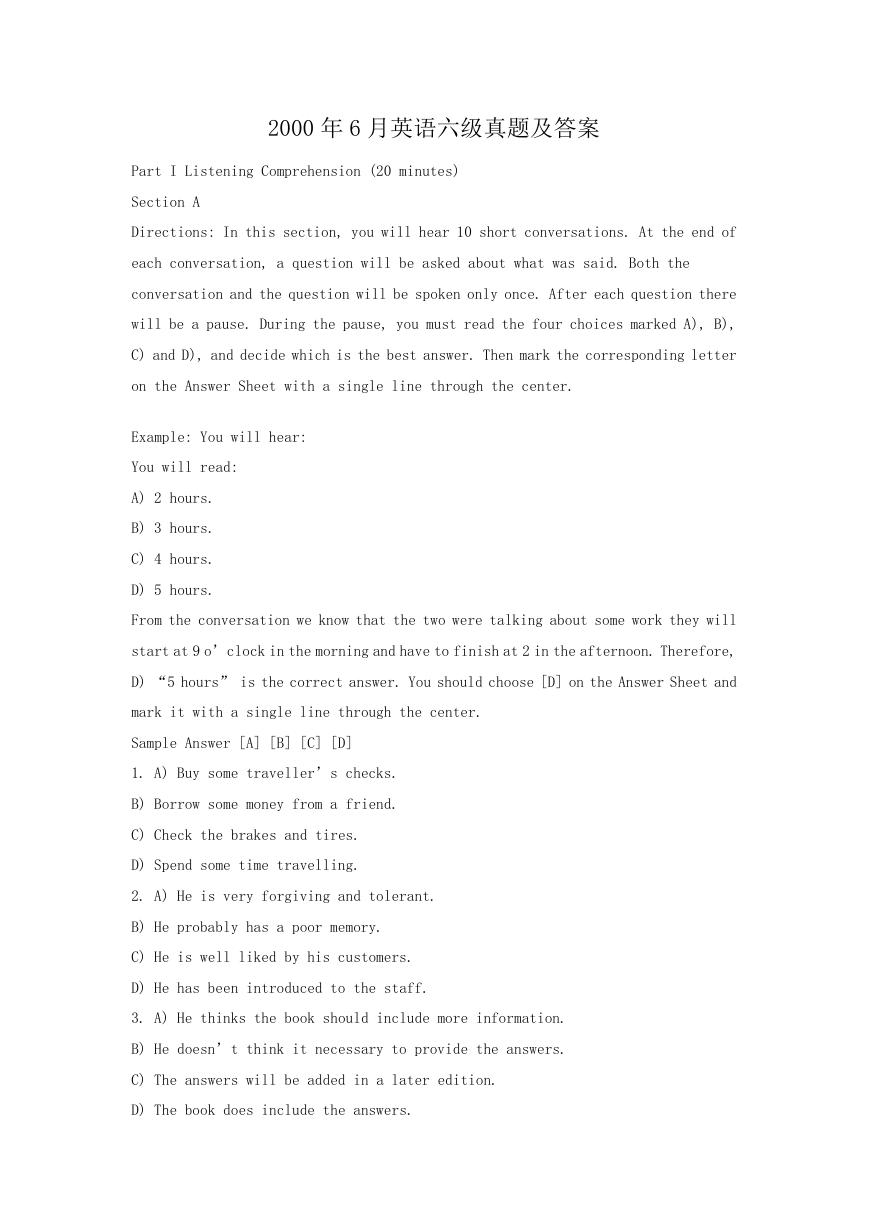
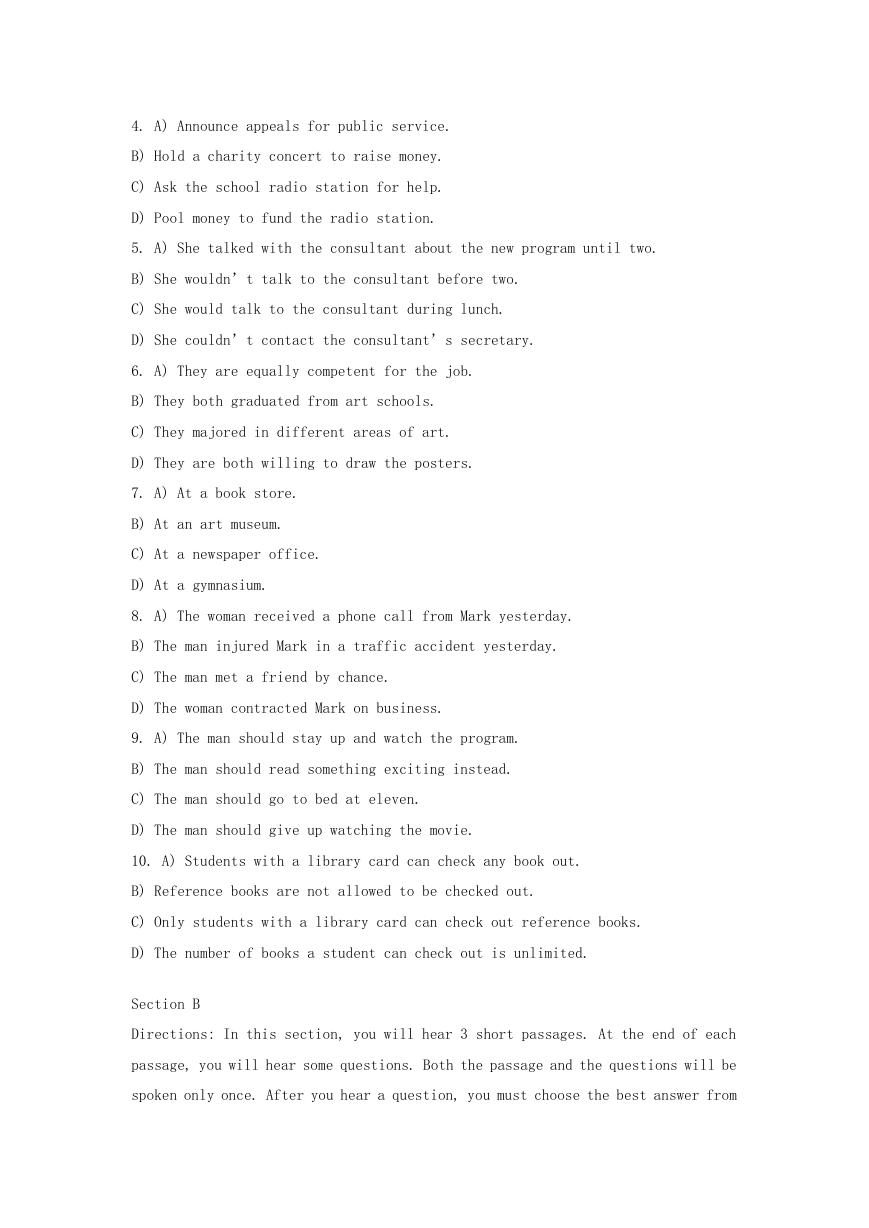
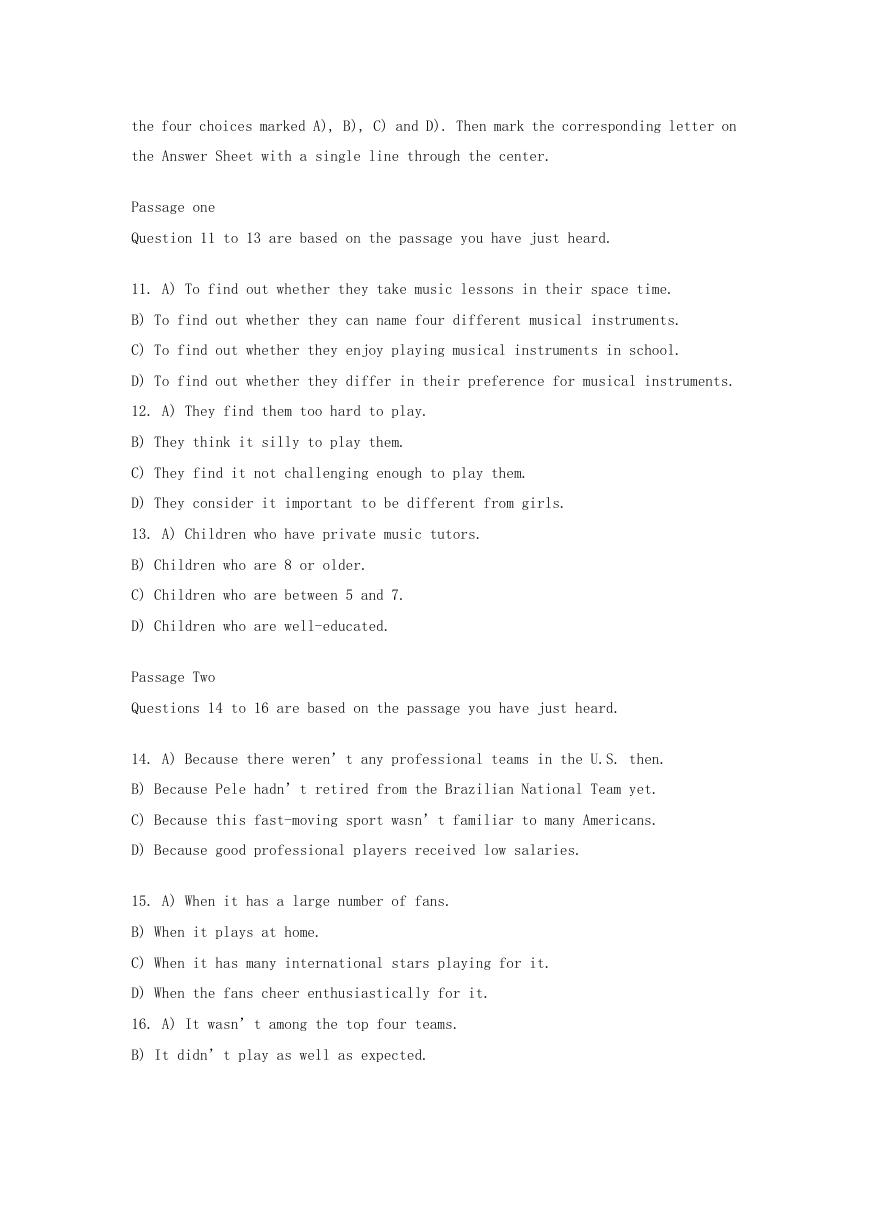
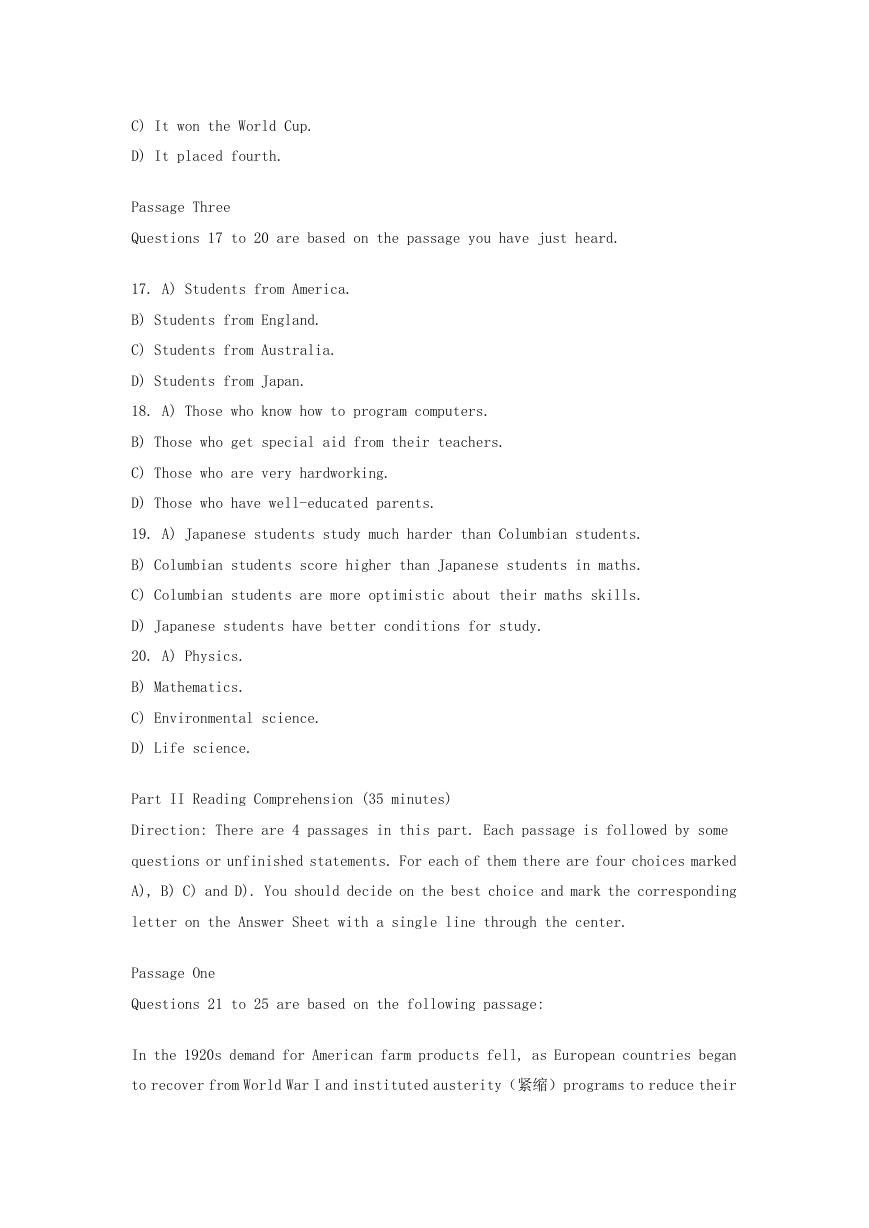
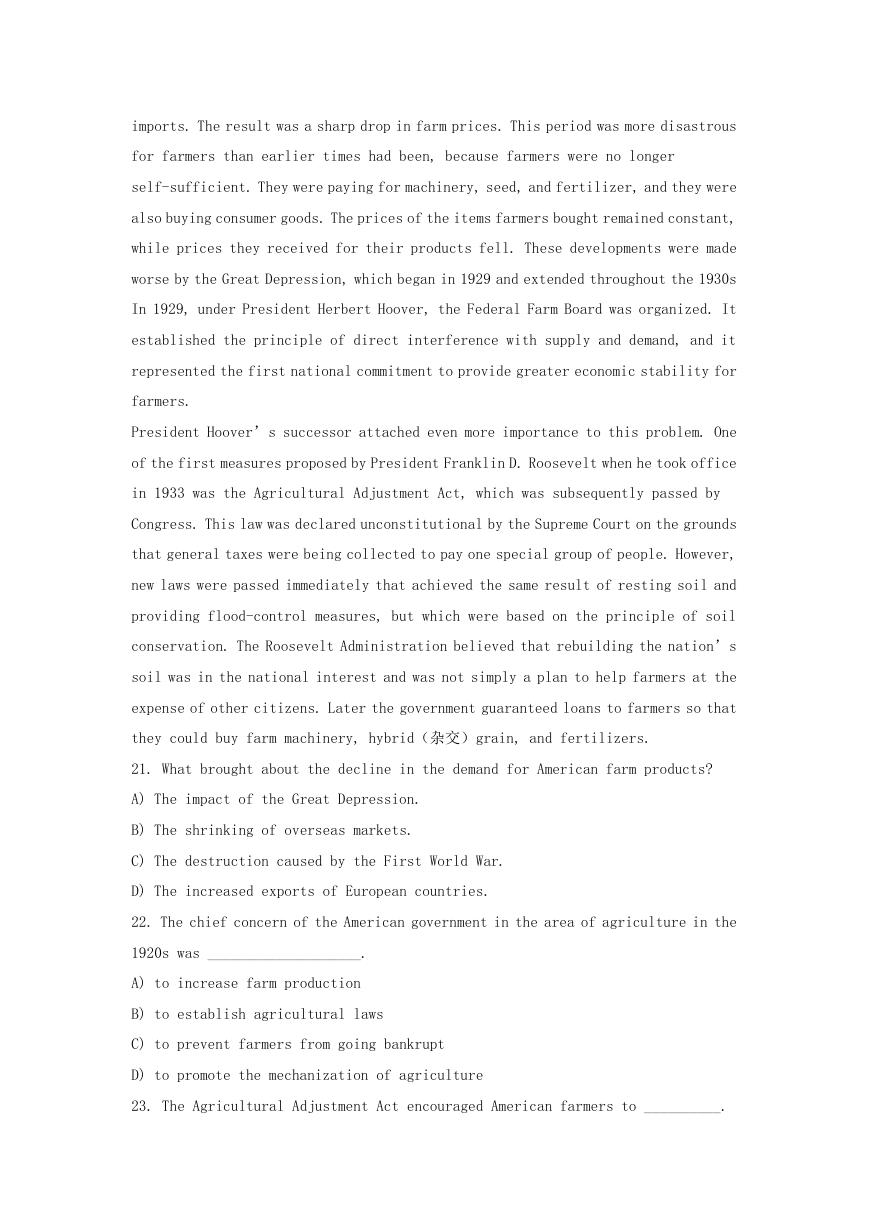
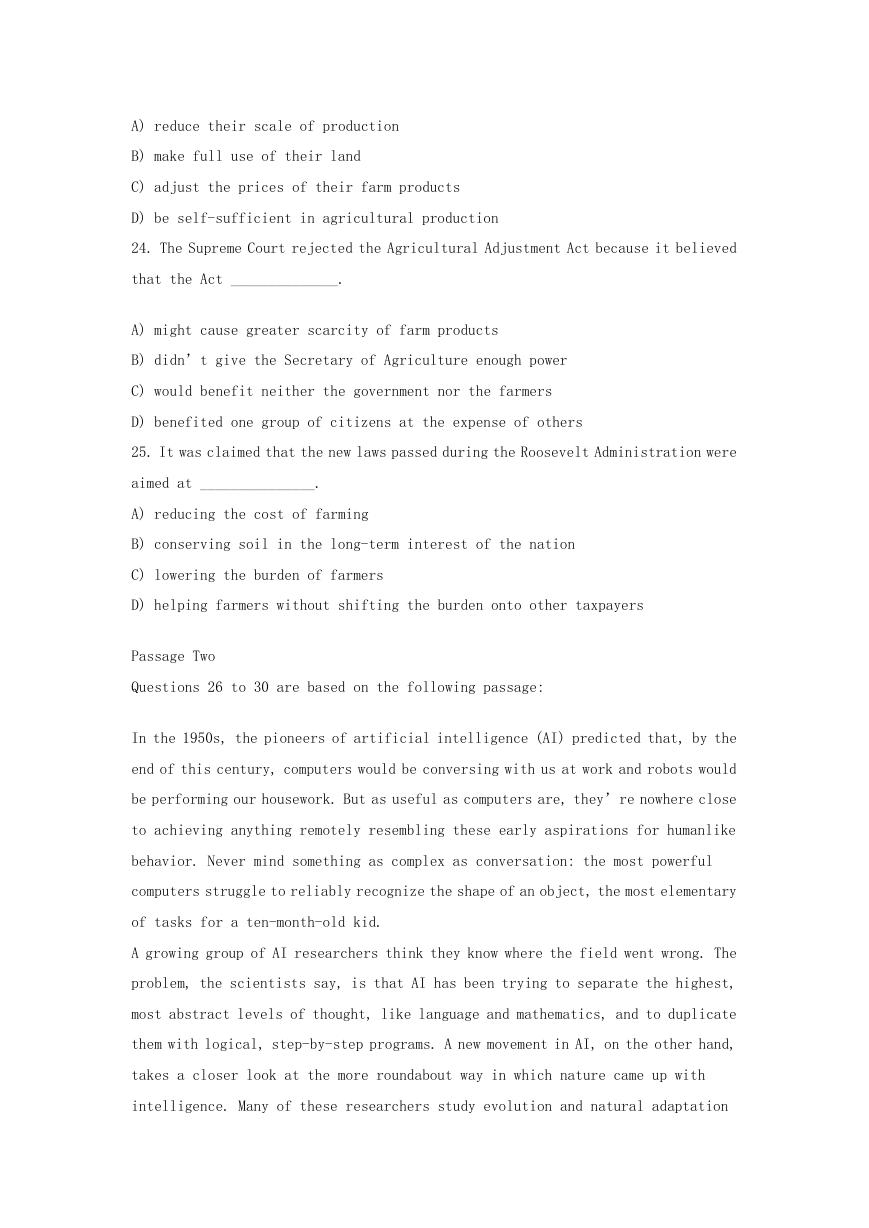
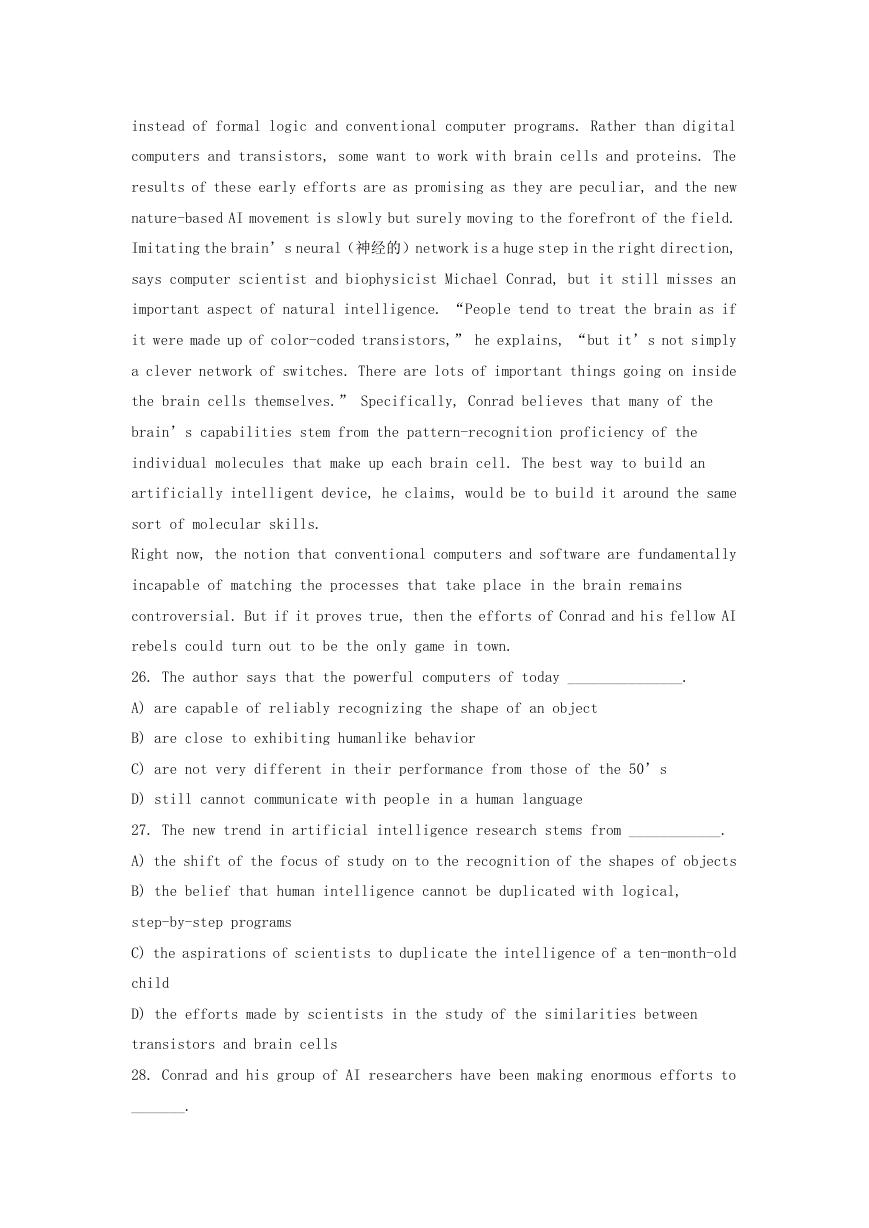









 2023年江西萍乡中考道德与法治真题及答案.doc
2023年江西萍乡中考道德与法治真题及答案.doc 2012年重庆南川中考生物真题及答案.doc
2012年重庆南川中考生物真题及答案.doc 2013年江西师范大学地理学综合及文艺理论基础考研真题.doc
2013年江西师范大学地理学综合及文艺理论基础考研真题.doc 2020年四川甘孜小升初语文真题及答案I卷.doc
2020年四川甘孜小升初语文真题及答案I卷.doc 2020年注册岩土工程师专业基础考试真题及答案.doc
2020年注册岩土工程师专业基础考试真题及答案.doc 2023-2024学年福建省厦门市九年级上学期数学月考试题及答案.doc
2023-2024学年福建省厦门市九年级上学期数学月考试题及答案.doc 2021-2022学年辽宁省沈阳市大东区九年级上学期语文期末试题及答案.doc
2021-2022学年辽宁省沈阳市大东区九年级上学期语文期末试题及答案.doc 2022-2023学年北京东城区初三第一学期物理期末试卷及答案.doc
2022-2023学年北京东城区初三第一学期物理期末试卷及答案.doc 2018上半年江西教师资格初中地理学科知识与教学能力真题及答案.doc
2018上半年江西教师资格初中地理学科知识与教学能力真题及答案.doc 2012年河北国家公务员申论考试真题及答案-省级.doc
2012年河北国家公务员申论考试真题及答案-省级.doc 2020-2021学年江苏省扬州市江都区邵樊片九年级上学期数学第一次质量检测试题及答案.doc
2020-2021学年江苏省扬州市江都区邵樊片九年级上学期数学第一次质量检测试题及答案.doc 2022下半年黑龙江教师资格证中学综合素质真题及答案.doc
2022下半年黑龙江教师资格证中学综合素质真题及答案.doc